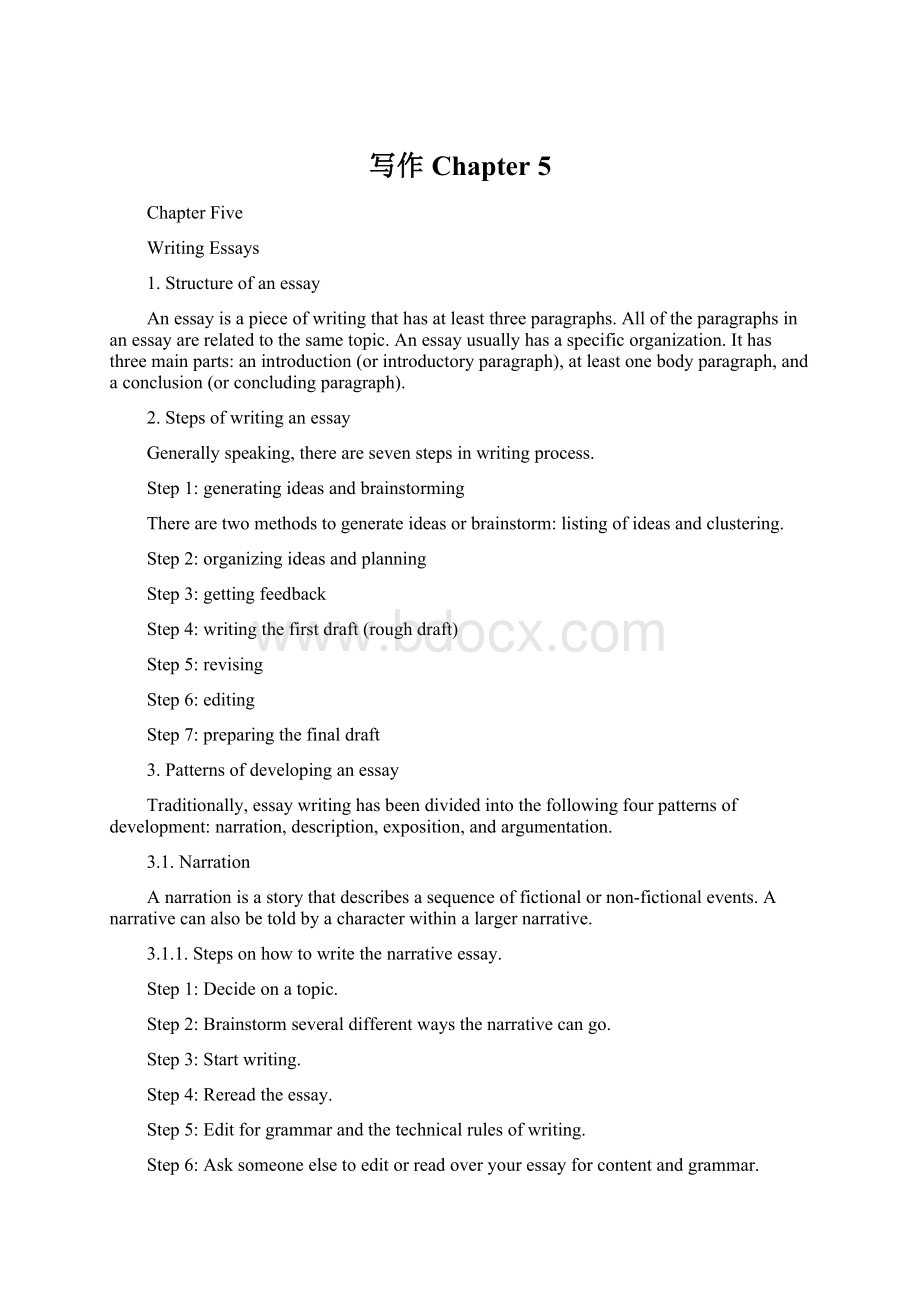写作Chapter 5.docx
《写作Chapter 5.docx》由会员分享,可在线阅读,更多相关《写作Chapter 5.docx(16页珍藏版)》请在冰豆网上搜索。

写作Chapter5
ChapterFive
WritingEssays
1.Structureofanessay
Anessayisapieceofwritingthathasatleastthreeparagraphs.Alloftheparagraphsinanessayarerelatedtothesametopic.Anessayusuallyhasaspecificorganization.Ithasthreemainparts:
anintroduction(orintroductoryparagraph),atleastonebodyparagraph,andaconclusion(orconcludingparagraph).
2.Stepsofwritinganessay
Generallyspeaking,therearesevenstepsinwritingprocess.
Step1:
generatingideasandbrainstorming
Therearetwomethodstogenerateideasorbrainstorm:
listingofideasandclustering.
Step2:
organizingideasandplanning
Step3:
gettingfeedback
Step4:
writingthefirstdraft(roughdraft)
Step5:
revising
Step6:
editing
Step7:
preparingthefinaldraft
3.Patternsofdevelopinganessay
Traditionally,essaywritinghasbeendividedintothefollowingfourpatternsofdevelopment:
narration,description,exposition,andargumentation.
3.1.Narration
Anarrationisastorythatdescribesasequenceoffictionalornon-fictionalevents.Anarrativecanalsobetoldbyacharacterwithinalargernarrative.
3.1.1.Stepsonhowtowritethenarrativeessay.
Step1:
Decideonatopic.
Step2:
Brainstormseveraldifferentwaysthenarrativecango.
Step3:
Startwriting.
Step4:
Rereadtheessay.
Step5:
Editforgrammarandthetechnicalrulesofwriting.
Step6:
Asksomeoneelsetoeditorreadoveryouressayforcontentandgrammar.
3.1.2.ElementsofNarration
Inorderforanarrationtobeinterestingandmeaningful,itmusthavethefollowingelements:
1.Emotion. Writingisreallysuchhardworkthatpeopleoughtnottobotherwritingsomethingwithwhichtheyarenotemotionallyinvolved.
2.Action. Somethinghappens,thatis,tensionincreasesandconflictintensifiesasvariouseventsoccur. Theaction,however,whetheritisexteriorandvisibleorinteriorandinvisible,causesthesituationtochangesothatconditionsaredifferentattheendofthestoryfromthewaytheywereatthebeginning. Thismovement,ordevelopment,isimportant.
3.Suspense.Eachpassagesuggeststhatsomethingisgoingtohappen sothatthereadereagerlyanticipatestheoutcomeoftheseevents. Tobuildsuspense,youplantseedsthathintatconflicts,problems,mysteries. Youpromisethereaderthatyouwillshowtheplantsinbloomandallconflicts,problems,andmysteriessolvedattheendofthestory. Suspenseisavitalelementinbuildingandretainingtheinterestofthereader.
4.Structureororder. Eventsinreallifehappeninadefiniteorder—theorderoftimeorchronologicalorder,butindiscoveringmeaningintheeventsorinimposingameaningonthem,thewritermayneedtoarrangethemdifferentlyfromtheorderinwhichtheyoriginallyoccurred,andthewritermayuseflashback.
5.Pointorpurpose. Thebeststorieshaveapurposeormeaningofsomekind. Indeed,eventhosewrittenandtoldfortheirownsakes,oftenmakesomekindofstatementofhumanbeings,humanvalues,orsomeaspectoflife. Togetthemostsatisfactionfromtheeffortthatgoesintowritinganarrative,selectanincidentinwhichyoucandiscoverameaningoraneventonwhichyoucanimposemeaning. Sometimesthemeaningisanoverallimpressionorattitude. Atothertimesitisanideathatcanbeexpressedinasinglesentence.
6.Pointofview. Ineverynarrative,someone(orsomething)tellsthestory,andthisperson,animalorthingmarksthestorywithhisorherpersonalimprint. Ifthestoryistoldinthefirst-person,youarenarratingeventsinthelifeofafictionalcharacterratherthanyours.Inthosecases,youhave“assumedapersona,”ortakenontheroleofanotherperson,muchasanactordoes. Youthenspeakconsistentlyfromthatperson’spointofview—seeingthingsasheorsheseesthem,reactingasthatpersonwould,andevenusingthelanguageappropriateforthecharacter. Sometimes,whenyouarereadingnarratives,itisdifficulttoseparatetheauthorfromthepersonaheorsheis“speakingthrough.” Anotherpointofviewoftenusedinnarrationisthird-personnarrator. Whentellingastoryfromthatpointofview,yourelateeventsasthoughyouwereanonlooker,andyouusethepronouns“he,”“she,”“it,”or“they.”
3.1.3.Tipsofwritinganarrative
Tip1:
Usinganemotiontostimulateanidea.
Tip2:
Concretepresentationinvolvesappropriateuseofdetails(sensorydetails,description,anddialogue).
Tip3:
Descriptioncanslowdownyourpace,sodonotdoitallthetimeinyourstory. Inotherwords,youmay“show”and“tell”inturn.
Tip4:
Dialogueisusuallyveryeffective.
Tip5:
Paymoreattentiontotheintroductoryparagraphofthenarrative.Itshouldbeginwithgeneralinformation,bemorespecificinthemiddle,andendwithathesisstatement.Usuallythethesisstatementfocusesonthestoryortheevent.
LookattheintroductionoftheessayaboutRosaParks,andthinkabouthowtowritethethesisstatementforanarration.
3.2.Description
Thepurposeofdescriptionistore-createorvisuallypresentaperson,place,event,oractionsothatthereadermaypicturethatwhichisbeingdescribed.Descriptiveessaysarelucidexplanationsanddescriptions.Theyusesensorydetailstoappealtoreaders.Theyareusuallythepersonalexperienceofanindividualandameansofexpressingtheindividual’sattitudeandtemperament.Descriptiveessayscanbeaboutaperson,aplace,anexperience,anobjectandsoon.
Descriptionessaysfollowthesamegeneralstructureasdootheressays.Whenwritingadescriptiveessay,trytosticktothisstructure.Intheintroduction,tellthereaderwhatthefocusofyouressayisgoingtobeandwhataspectsoftheobjectyouwillbefocusingon.Inthebodyofthepaperdescribeplaces,peopleandeventsinvividmanner.Delveintothesubjectinasmuchdetailaspossible.Describethewholethingasyouhaveseenit.Usewordsthatappealtothesenses.Andintheconclusion,restatetheessenceofyourthesisandsummarizeyourthoughts.Writingadescriptiveessayisnotalwayseasy.Henceyoumayberequiredtodraftandredrafttillitturnsoutthewayyouwantitto.
Asyouwriteyourdescriptiveessay,thebestwaytocreateavividexperienceforyourreadersistofocusonthefivesenses:
sight,sound,smell,touchandtaste.
3.2.1.Sevenstepstodescriptivewriting
Step1.Readthetopicthoughtfullyandcarefully.
Step2.Avoidwritingastory.Eventhoughallnarrativeorstorytellingdependsondescriptiontosetasceneormood,whenwritingtodescribe,it’sbesttoavoidwritingastory.Sticktodescribing,makingthereadersfeelasiftheywereactuallyexperiencingthethingbeingdescribed.
Step3.Describeonlywhatisrelevanttohelpingdeveloptheunderlyingmessage.Recognisingwhattoincludeandwhattoleaveoutinapieceofdescriptivewritingisvitaltomakingiteffective.Effectivedescriptionisfinelydetailedbutverycarefullyfocused.Byincludingonlywhatisrelevant,effectivedescriptionaddsunityandcoherencetowriting.
Step4.Putyourreaderintotherightframeofmindtobecomeinvolvedinyourwriting.Interestandinvolvementarecentraltoagoodreaderresponse.Withoutityourwritingwillnotworkwell.It’simportanttouseyourdescriptiontocreate,developorassistamoodsuitedtoyoursubjectmatterortheme.
Step5.Describe“howyoufeltatthetime”-makethereaderfeelasiftheywere‘there’.Describewhatyousee,hear,taste,smell,andfeel.Youprobablydoneedadjectivestodothis,buttryhardtofindwordsthatdonotneedanadjectiveifyoucan.Chooseprecisevocabulary—thekindofwordsthatalmostcontaintheirowndescription—asthiswillbefarmoreinterestingtoread.Andusevividsimilesandmetaphorswhichhelptoetchanimageintoyourreader’simagination.
Step6.Avoidexcessiveorboringdescription.Ifyoudodescribeallofyournounswithextraadjectives,theeffectisactuallytoweakenthedescription.Itisbettertofollowtheadvicegivenaboveandchooseprecisevocabulary.Besides,whatstrengthensdescriptionagreatdealistouseafewbutcarefullychosenandvividsimilesandmetaphors.
Step7.Createaclearstructure.Aplannedstructureprovides“shape”toyourwritingandaddsenormouslytoitseffect.Aimtodescribeaspectsofasceneinaninterestingandlogicalorder,onethatseems“natural”toyourreader.Thismightmeanworkingfrominsidetooutside,fromthepasttothefuture,fromthegeneraltotheparticular,fromthesmalltothelarge,andsoon.
3.3.Exposition
Expositionisatypeoforalorwrittendiscoursethatisusedtoexplain,describe,giveinformationorinform.Thepurposeofexpositionistopresentbackground,completelyandfairly,andinformthereadersabouttheplot,character,setting,andthemeoftheessayorstory,ormotionpicture.Suchwritingisdiscoursedesignedtoconveyinformationorexplainwhatisdifficulttounderstand.Sinceclarityrequiresstrongorganization,expositionusuallyproceedsbytheorderlyanalysisofpartsandtheuseoffamiliarillustrationsoranalogies.
3.3.1.SomeExpositoryOrganizationalPatterns
Inordertogivemoreinformationaboutoralandwrittenexposition,eightdifferentexamplesofexpositoryorganizationalpatternsareprovided.Mostoftheseorganizationalpatternsareveryfamiliartoyou.
Pattern
Description
CueWords
Circumlocution
Depictsapatterninwhichthespeakerdiscussesatopic;thendivertstodiscussarelatedbutdifferenttopic.
NarrativeInterspersion
Apatternorasub-patternimbeddedinotherpatternsinwhichthespeakerorwriterinterspersesanarrativewithintheexpo